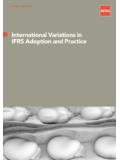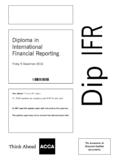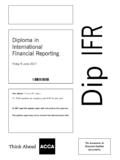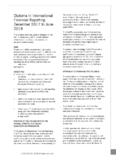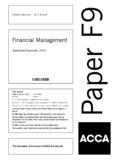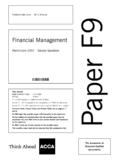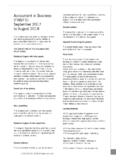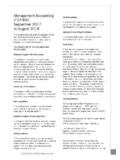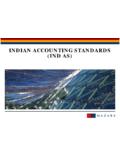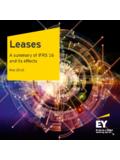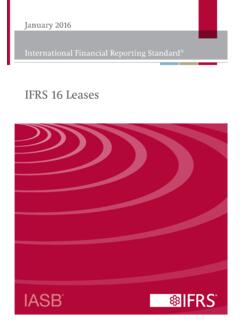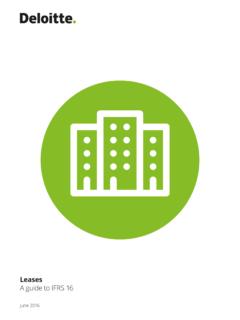Transcription of Examiner’s report - ACCA Global
1 Examiner s reportP2 Corporate ReportingJune 2017 examiner s report P2 June 20171 General CommentsThe examination consisted of two sections. Section A contained one question for 50 marks and Section Bcontained three questions of 25 marks each, from which candidates had to answer two pass this examination, candidates must be conscious of time, they must have discipline and the energy toobtain the required level of knowledge and to apply it appropriately. The nature of the examination shoulddictates the approach to learning. There is a significant amount of information to be learned and understood and,as a result, candidates often adopt a superficial approach to learning, as it appears that their goal is simply topass an exam and not prepare themselves for a career in accounting.
2 However, this examination rewardspersonal understanding and not superficial learning. The verbs used in the examination are discuss, advise,explain and analyse which means that superficial learning is not sufficient to develop the professional skillsrequired. It appears from the examination scripts that there is considerable diversity in how students approachtheir learning with many candidates focusing on the bare fundamentals. These candidates reproduce themthrough rote learning, rather than reading wider to engage with the subject. It appears that some candidates havea preconception that corporate reporting is a subject that does not require deep understanding.
3 A deep approachto learning is positively associated with good performance in the P2 perceive and answer questions from a narrow perspective. It may be they feel that certain educationalstrategies (such as case studies) are not effective. However, it is important that both candidates and tutors thinkabout how the learning process might be mentioned in previous reports, IFRSs can be learned and taught through the medium of the ConceptualFramework. This method of learning and teaching can develop a critical approach to corporate reporting bydemonstrating, for example, the inconsistency of the application of the fundamental principles of One aThis question requires candidates to prepare a consolidated financial statement; either cash flow, financialposition or a statement of profit or loss and other comprehensive income.
4 Invariably in all of the above financialstatements, goodwill on acquisition has to be calculated using fair value (sometimes called the full goodwillmethod), or the NCI's proportionate share of net assets of the acquiree. Candidates in the main, calculategoodwill correctly. However, the calculation of goodwill normally only carries between 5-7 marks dependent onthe number of subsidiaries and the complexity of the calculation. In addition, this calculation must be correct togain full marks as seldom does the own figure rule apply. This is because the information for the calculation isgenerally obtained from the , gains or losses on disposal of a subsidiary can be examined in the case of all three statements.
5 Thus,candidates should understand the principles behind the disposal of part of the holding to the NCI, disposal of acontrolling interest whilst retaining an associate holding and the disposal of the whole of the interest. Theseelements of the consolidated statements are not well answered and yet the disposal can carry between s report P2 June 20172 The treatment of associates and joint ventures/arrangements can be asked in most group questions. Theidentification and accounting for associates is a regular examination topic and candidates generally do well in thisarea. However, the accounting for an investment prior to control being obtained is not well answered.
6 Theacquirer accounts for its investment in the equity interests of an acquiree in accordance with the nature of theinvestment by applying the relevant standard which could be for example, IFRS 9, IAS 28, or IFRS part ofaccounting for the business combination, the acquirer remeasures any previously held interest at fair value andtakes this amount into account in the determination of goodwill. It is this last element that often is answeredpoorly. The marks for this element of the question can vary according to its treatment of NCI can be asked in most group questions. For example, in a cash flow question, the dividendpaid to NCI will be required, in a statement of profit or loss and other comprehensive income, the NCIs share ofprofit will be required and obviously in a SOFP, the closing balance on the NCI account is required.
7 Thetreatment of NCI can bring relatively easy marks to the candidate. Often the own figure rule (OFR) will be usedbecause the reserves or profit figure used to determine NCI may have been calculated by the candidate. If thefigures needed to calculate NCI are given in the question then the OFR will not be used. Generally, candidatesscore well in this area but it is important that the principle behind the calculations is understood. The NCIcalculation can carry up to 4 group SOFP questions, the group retained earnings calculation is extremely important from the viewpoint ofaccruing credit. This section can carry up to 6 marks. Again, the OFR rule will apply here on the same basis asabove.
8 Candidates generally score well in this area. Thus if one reviews this examiners report thus far, it can beseen that certain areas are critical to success. A good understanding of group accounting is essential but as setout in the opening paragraphs, this understanding must be deep, as it has to be applied to the many scenariosthat the examiner can create. If candidates concentrate on the main facts with retention of information andtechnique being important, they will struggle with the different scenarios within the examination. If candidatesonly memorise the information, and do not understand the meaning, there will be a reduced chance of success inthis comprehensive income (OCI) will normally carry up to 3 marks and be marked on the same basis as remainder of the elements in question 1 centre around the adjustments required to theconsolidated statements can vary from pension adjustments to investment properties and leases.
9 The marks forthese adjustments would tend to be between 3 and 4 marks. The adjustments require not only an understandingof the IFRS but also an understanding of the accounting question usually asks for the preparation of a particular consolidated financial statement. In the case ofgroup cash flow statements, the layout of the answer is quite important because of the specific requirements ofIAS 7. However, there are no marks in a group SOFP for simply adding together digits given in the question ifthere has been no adjustment to the original 1b and c generally extend the scenario in question 1and focus on IFRS and in the case of 1c, ethicalrequirements.
10 There are wide ranges of topic areas, which have been asked in this part of the question, andgenerally, candidates struggle to discuss the issues involved. The reasons for this have been set out in theintroduction to this , there is very little accounting required in this part of the question and the questions generally require adiscussion of the issues. Over recent diets, candidates have focused on the accounting issues in question 1c tothe detriment of the discussion of the ethical issues. Additionally, the discussion of the ethical issues is veryExaminer s report P2 June 20173superficial. There seems to be very little application of ACCA s ethical framework approach in the resolution ofthe ethical dilemma set out in the TwoThis question can be based upon a theme, for example fair valuation, or can simply be based upon 3 specificscenarios.
